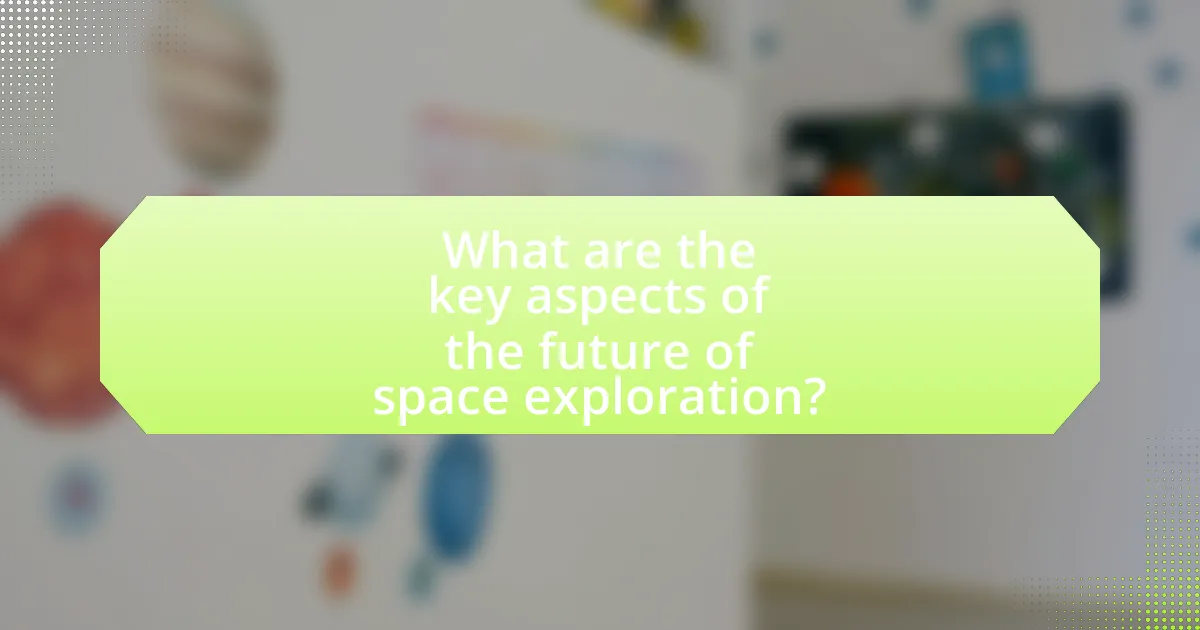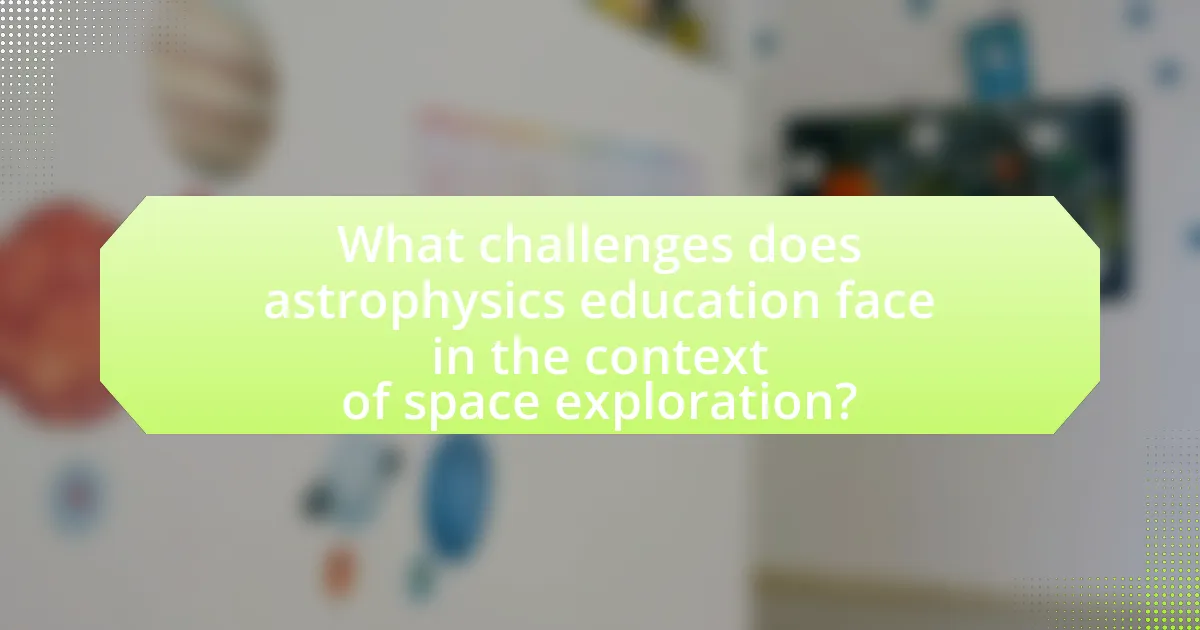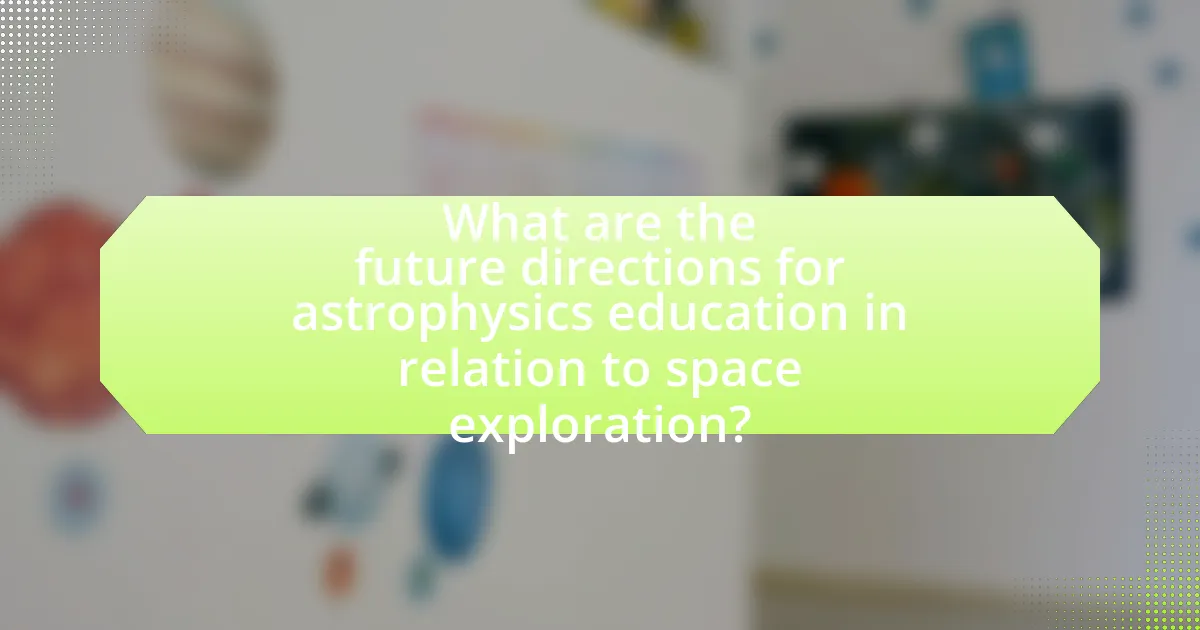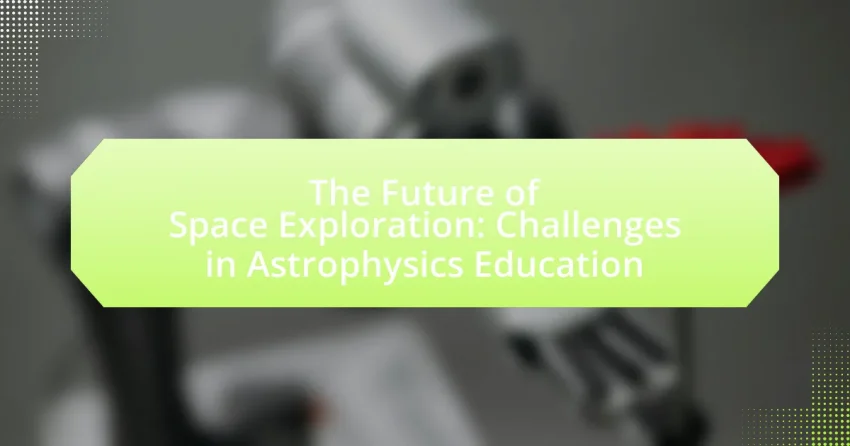The article focuses on the future of space exploration and the challenges faced in astrophysics education. It highlights key aspects such as technological advancements, international collaboration, and sustainable practices that are shaping space missions. The discussion includes the role of robotics and AI, advancements in propulsion systems, and the importance of partnerships among countries and organizations. Additionally, it addresses the barriers in astrophysics education, the need for interdisciplinary approaches, and the significance of mentorship and hands-on experiences for students pursuing careers in this field. The article emphasizes the potential benefits of space exploration for humanity and the necessity of adapting educational frameworks to meet future demands.

What are the key aspects of the future of space exploration?
The key aspects of the future of space exploration include advancements in technology, international collaboration, and the pursuit of sustainable practices. Advancements in technology, such as reusable rockets and autonomous spacecraft, are reducing costs and increasing access to space. International collaboration is exemplified by partnerships like the Artemis program, which aims to return humans to the Moon and establish a sustainable presence there by the 2020s. Additionally, the focus on sustainable practices, including in-situ resource utilization, is essential for long-term missions to Mars and beyond, as it allows for the use of local materials to support human life. These aspects are critical for addressing the challenges of space exploration and ensuring its viability for future generations.
How is technology shaping the future of space exploration?
Technology is shaping the future of space exploration by enabling advanced spacecraft, enhancing data analysis, and facilitating international collaboration. Innovations such as reusable rockets, exemplified by SpaceX’s Falcon 9, significantly reduce launch costs and increase access to space. Additionally, artificial intelligence and machine learning improve the processing of vast amounts of data collected from missions, allowing for more efficient decision-making and scientific discoveries. Furthermore, advancements in communication technologies enable real-time data sharing among global space agencies, fostering collaborative projects like the International Space Station. These technological developments collectively drive the exploration of Mars, the Moon, and beyond, making ambitious missions more feasible and sustainable.
What advancements in propulsion systems are being developed?
Advancements in propulsion systems currently being developed include ion propulsion, nuclear thermal propulsion, and solar sails. Ion propulsion systems, such as those used in NASA’s Dawn spacecraft, utilize electric fields to accelerate ions, providing efficient thrust over long durations. Nuclear thermal propulsion, being researched by NASA and other organizations, promises higher efficiency and greater thrust compared to conventional chemical rockets, potentially reducing travel time to Mars. Solar sails, which harness sunlight for propulsion, are being tested in missions like The Planetary Society’s LightSail, demonstrating the feasibility of using solar energy for deep space exploration. These advancements aim to enhance the efficiency, speed, and sustainability of future space missions.
How are robotics and AI influencing space missions?
Robotics and AI are significantly enhancing space missions by enabling autonomous operations, improving data analysis, and facilitating complex decision-making processes. For instance, NASA’s Mars rovers, such as Perseverance, utilize AI algorithms for navigation and obstacle avoidance, allowing them to operate independently on the Martian surface. Additionally, AI systems analyze vast amounts of data collected from space missions, identifying patterns and anomalies that human analysts might overlook. This capability was demonstrated during the Kepler mission, where AI helped in the discovery of new exoplanets by processing light curve data efficiently. Overall, the integration of robotics and AI in space exploration leads to increased mission efficiency, reduced human error, and the ability to conduct operations in environments that are hazardous or inaccessible to humans.
What role do international collaborations play in space exploration?
International collaborations are essential in space exploration as they pool resources, expertise, and technology from multiple countries, enhancing the capabilities and reach of space missions. For instance, the International Space Station (ISS) is a prime example, involving contributions from NASA, Roscosmos, ESA, JAXA, and CSA, which collectively enable advanced scientific research and foster international cooperation in space. Such collaborations also facilitate cost-sharing, reduce redundancy in research and development, and promote the sharing of scientific data, thereby accelerating advancements in astrophysics and related fields.
Which countries are leading in space exploration initiatives?
The countries leading in space exploration initiatives are the United States, Russia, China, and the European Union. The United States, through NASA, has been at the forefront with missions like the Mars Perseverance Rover and the Artemis program aimed at returning humans to the Moon. Russia has a long history in space exploration, exemplified by its Soyuz program and contributions to the International Space Station. China has rapidly advanced its space capabilities, achieving milestones such as the Chang’e lunar missions and the Tianwen-1 Mars mission. The European Union, through the European Space Agency, has also made significant contributions, including the Rosetta mission and ongoing Earth observation programs. These countries are recognized for their substantial investments and achievements in space technology and exploration.
How do partnerships enhance scientific research in space?
Partnerships enhance scientific research in space by facilitating resource sharing, expertise exchange, and collaborative problem-solving. For instance, international collaborations like the International Space Station (ISS) bring together multiple countries’ space agencies, allowing them to pool funding, technology, and scientific knowledge. This collective effort has led to significant advancements in areas such as microgravity research, where diverse teams conduct experiments that benefit from varied perspectives and methodologies. Additionally, partnerships with private companies, such as SpaceX and Blue Origin, have accelerated innovation and reduced costs, enabling more frequent and diverse missions. These collaborations exemplify how partnerships can amplify the impact and scope of scientific research in space.
What are the potential benefits of space exploration for humanity?
Space exploration offers numerous potential benefits for humanity, including advancements in technology, scientific knowledge, and international collaboration. Technological innovations developed for space missions, such as satellite communications and GPS, have transformed everyday life on Earth. Scientific discoveries from space exploration, like understanding climate change through satellite data, enhance our knowledge of planetary systems and the universe. Additionally, international collaboration in space missions fosters peaceful relations among countries, exemplified by partnerships in the International Space Station program, which includes contributions from NASA, ESA, Roscosmos, JAXA, and CSA. These benefits collectively contribute to the advancement of society and the betterment of life on Earth.
How can space exploration contribute to solving Earth’s problems?
Space exploration can contribute to solving Earth’s problems by advancing technology and providing insights into climate change. For instance, satellite technology developed for space missions enables precise monitoring of Earth’s climate, allowing scientists to track changes in temperature, sea levels, and greenhouse gas emissions. NASA’s Earth Observing System satellites have provided critical data that informs climate models and policy decisions, demonstrating the direct impact of space exploration on understanding and addressing environmental challenges. Additionally, innovations in materials science and renewable energy technologies, often derived from space research, can lead to sustainable solutions for energy production and resource management on Earth.
What new resources can be discovered through space exploration?
Space exploration can lead to the discovery of new resources such as water, rare minerals, and potential energy sources. For instance, water ice has been found on the Moon and Mars, which could support future human missions and serve as a resource for hydrogen fuel. Additionally, asteroids are known to contain valuable metals like platinum and gold, with the asteroid 16 Psyche estimated to hold resources worth trillions of dollars. These findings highlight the potential for space exploration to unlock significant resources that could benefit Earth and future space endeavors.

What challenges does astrophysics education face in the context of space exploration?
Astrophysics education faces significant challenges in the context of space exploration, primarily due to the rapid advancement of technology and the need for interdisciplinary knowledge. As space exploration evolves, educational programs must adapt to incorporate new scientific discoveries and technological tools, which can overwhelm existing curricula. Additionally, the shortage of qualified educators with expertise in both astrophysics and practical space applications limits the effectiveness of teaching. According to a report by the National Academies of Sciences, Engineering, and Medicine, there is a critical need for enhanced training programs that bridge theoretical knowledge with hands-on experience in space missions. This gap in education can hinder the development of a skilled workforce necessary for future space exploration initiatives.
How is the current educational framework addressing astrophysics?
The current educational framework is addressing astrophysics through integrated curricula that emphasize interdisciplinary learning and practical applications. Educational institutions are increasingly incorporating astrophysics into science programs, utilizing hands-on experiments, simulations, and collaborative projects to enhance student engagement. For instance, the inclusion of astrophysics in STEM (Science, Technology, Engineering, and Mathematics) initiatives has been shown to improve critical thinking and problem-solving skills among students, as evidenced by programs like NASA’s Space Grant Consortium, which supports research and education in space science across various universities.
What are the gaps in astrophysics curriculum at various educational levels?
The gaps in astrophysics curriculum at various educational levels include insufficient integration of interdisciplinary approaches, limited hands-on research opportunities, and a lack of emphasis on emerging technologies. At the undergraduate level, many programs do not adequately incorporate fields such as computer science and engineering, which are crucial for modern astrophysics research. Graduate programs often lack practical experience in observational techniques and data analysis, which are essential for real-world applications. Furthermore, educational institutions frequently overlook the importance of teaching students about current advancements in astrophysics, such as exoplanet research and gravitational wave astronomy, leading to a curriculum that does not fully prepare students for contemporary challenges in the field.
How do teaching methods impact student engagement in astrophysics?
Teaching methods significantly impact student engagement in astrophysics by influencing how effectively students grasp complex concepts and relate them to real-world applications. Active learning strategies, such as problem-based learning and interactive simulations, have been shown to enhance student interest and participation, as evidenced by a study conducted by Freeman et al. (2014) in the Proceedings of the National Academy of Sciences, which found that active learning increased student performance in STEM subjects by 6%. Furthermore, incorporating technology, such as virtual labs and online resources, fosters a more immersive learning experience, leading to higher engagement levels. Thus, the choice of teaching methods directly correlates with the degree of student engagement in astrophysics education.
What barriers exist for students pursuing astrophysics education?
Barriers for students pursuing astrophysics education include high costs of education, limited access to resources, and a lack of representation in the field. The financial burden of tuition and fees can deter students from enrolling in astrophysics programs, as evidenced by a report from the National Center for Education Statistics indicating that students often accumulate significant debt. Additionally, many educational institutions lack adequate facilities and equipment for hands-on learning, which is crucial for understanding complex astrophysical concepts. Furthermore, underrepresented groups face systemic challenges, including fewer role models and mentors, which can lead to feelings of isolation and discourage participation in astrophysics. These barriers collectively hinder the pursuit of astrophysics education and limit diversity within the field.
How does funding affect access to astrophysics programs?
Funding significantly affects access to astrophysics programs by determining the availability of resources, faculty, and research opportunities. Institutions with higher funding can offer more scholarships, advanced equipment, and better facilities, which attract a diverse student body. For instance, the National Science Foundation reported that universities receiving substantial grants can increase enrollment in STEM fields, including astrophysics, by up to 30%. Conversely, programs with limited funding often struggle to maintain quality education and outreach, leading to reduced access for underrepresented groups.
What role does mentorship play in student success in astrophysics?
Mentorship plays a crucial role in student success in astrophysics by providing guidance, support, and networking opportunities essential for academic and professional development. Effective mentorship helps students navigate complex subjects, enhances their research skills, and fosters critical thinking, which are vital in a challenging field like astrophysics. Studies indicate that students with mentors are more likely to pursue advanced degrees and careers in STEM fields, as mentorship often leads to increased confidence and motivation. For instance, a report by the National Mentoring Partnership highlights that mentees are 55% more likely to enroll in college and 78% more likely to hold leadership positions, underscoring the significant impact of mentorship on educational outcomes.
How can educational institutions adapt to the needs of future space exploration?
Educational institutions can adapt to the needs of future space exploration by integrating interdisciplinary curricula that emphasize STEM education, particularly in fields like astrophysics, engineering, and computer science. This approach prepares students for the complex challenges of space missions, as evidenced by NASA’s emphasis on a skilled workforce capable of tackling advanced technological problems. Additionally, partnerships with space agencies and private aerospace companies can provide students with hands-on experience and exposure to real-world applications, enhancing their readiness for careers in space exploration. Programs like internships and collaborative research projects further align educational outcomes with industry needs, ensuring that graduates possess relevant skills and knowledge.
What innovative teaching strategies can enhance astrophysics education?
Innovative teaching strategies that can enhance astrophysics education include the use of interactive simulations, project-based learning, and collaborative online platforms. Interactive simulations allow students to visualize complex astrophysical concepts, such as gravitational waves or black hole dynamics, making abstract ideas more tangible. Project-based learning engages students in real-world problems, fostering critical thinking and problem-solving skills; for instance, students can work on projects that involve analyzing astronomical data from telescopes. Collaborative online platforms, such as virtual classrooms and discussion forums, enable students to connect with peers and experts globally, enhancing their learning experience through diverse perspectives. These strategies have been shown to improve student engagement and understanding, as evidenced by studies indicating that active learning approaches can lead to higher retention rates in STEM fields.
How can partnerships with space agencies improve educational outcomes?
Partnerships with space agencies can significantly improve educational outcomes by providing access to cutting-edge research, resources, and real-world applications of science and technology. These collaborations enable educational institutions to incorporate hands-on learning experiences, such as internships and research projects, which enhance student engagement and understanding of complex astrophysics concepts. For instance, NASA’s educational programs, like the Artemis Student Challenges, allow students to work on projects related to lunar exploration, fostering critical thinking and problem-solving skills. Additionally, partnerships can facilitate teacher training and curriculum development, ensuring that educators are equipped with the latest knowledge and tools to inspire the next generation of scientists.

What are the future directions for astrophysics education in relation to space exploration?
Future directions for astrophysics education in relation to space exploration include integrating hands-on experiences with emerging technologies and fostering interdisciplinary collaboration. Educational institutions are increasingly adopting project-based learning that incorporates real-world space missions, such as NASA’s Artemis program, which aims to return humans to the Moon and eventually send astronauts to Mars. This approach enhances student engagement and understanding of complex astrophysical concepts. Additionally, partnerships between universities and space agencies are being established to create specialized curricula that align with current and future space exploration goals, ensuring that students are equipped with relevant skills and knowledge. These initiatives are supported by data indicating that experiential learning significantly improves retention and application of scientific principles in students.
How can technology be integrated into astrophysics education?
Technology can be integrated into astrophysics education through the use of interactive simulations, virtual reality, and online collaborative platforms. Interactive simulations allow students to visualize complex astrophysical phenomena, such as black holes and cosmic events, enhancing their understanding through experiential learning. Virtual reality can immerse students in simulated space environments, providing a hands-on approach to learning about celestial mechanics and astronomical observations. Online collaborative platforms facilitate global partnerships among students and educators, enabling shared research projects and discussions that broaden perspectives on astrophysical challenges. These methods have been shown to improve engagement and comprehension in STEM education, as evidenced by studies indicating that students using technology-enhanced learning tools perform better academically compared to traditional methods.
What tools and resources are available for online astrophysics learning?
Online astrophysics learning is supported by a variety of tools and resources, including Massive Open Online Courses (MOOCs) like Coursera and edX, which offer courses from institutions such as Stanford and MIT. Additionally, platforms like Khan Academy provide free educational videos on fundamental astrophysics concepts. Interactive simulations and software, such as Universe Sandbox, allow learners to visualize astronomical phenomena. Furthermore, online forums and communities, such as Stack Exchange and Reddit’s r/astrophysics, facilitate discussion and peer support among learners. These resources collectively enhance the accessibility and understanding of astrophysics for students worldwide.
How can virtual reality enhance the learning experience in astrophysics?
Virtual reality can enhance the learning experience in astrophysics by providing immersive simulations that allow students to visualize complex astronomical concepts and phenomena. This technology enables learners to explore celestial bodies, such as planets and stars, in a three-dimensional space, facilitating a deeper understanding of their structures and behaviors. Research conducted by the University of Illinois demonstrated that students using virtual reality for astrophysics education showed a 30% improvement in retention of information compared to traditional learning methods. By engaging with interactive environments, students can experiment with gravitational forces and orbital mechanics, making abstract theories more tangible and comprehensible.
What best practices can educators implement to inspire future astrophysicists?
Educators can inspire future astrophysicists by integrating hands-on experiments and real-world applications into their curriculum. Engaging students with interactive projects, such as building simple telescopes or conducting simulations of celestial phenomena, fosters a practical understanding of astrophysics concepts. Research indicates that experiential learning significantly enhances student interest and retention in STEM fields, with studies showing that students involved in hands-on activities are more likely to pursue careers in science and technology. Additionally, incorporating current events in space exploration, such as missions by NASA or private companies, can contextualize learning and spark curiosity. By connecting theoretical knowledge to contemporary advancements, educators can effectively motivate students to explore astrophysics further.
How can real-world space missions be incorporated into the curriculum?
Real-world space missions can be incorporated into the curriculum by integrating project-based learning that aligns with current space exploration initiatives. Educators can utilize data and findings from missions like NASA’s Mars Rover or the James Webb Space Telescope to create hands-on activities that enhance students’ understanding of astrophysics concepts. For instance, analyzing real-time data from these missions allows students to engage in scientific inquiry and develop critical thinking skills. Research shows that experiential learning, such as using authentic data from space missions, significantly improves student engagement and comprehension in STEM subjects (National Research Council, 2012).
What role do outreach programs play in promoting astrophysics education?
Outreach programs play a crucial role in promoting astrophysics education by increasing public engagement and accessibility to complex scientific concepts. These programs often include workshops, public lectures, and hands-on activities that demystify astrophysics, making it more relatable and understandable for diverse audiences. For instance, initiatives like NASA’s “Night Sky Network” provide resources and events that connect local communities with astronomy experts, fostering interest and knowledge in the field. Research indicates that such outreach efforts can significantly enhance students’ interest in STEM subjects, with studies showing that participation in science outreach can lead to a 30% increase in students pursuing related academic paths.
What practical steps can students take to prepare for a career in astrophysics?
Students can prepare for a career in astrophysics by pursuing a strong foundation in mathematics and physics, engaging in research opportunities, and gaining relevant experience through internships. A solid understanding of calculus, differential equations, and classical mechanics is essential, as these subjects form the basis of astrophysical concepts. Participating in research projects, such as those offered by university faculty or through summer research programs, allows students to apply theoretical knowledge and develop practical skills. Additionally, internships at research institutions or space agencies provide hands-on experience and networking opportunities, which are crucial for career advancement in the field of astrophysics.
How can students gain hands-on experience in astrophysics research?
Students can gain hands-on experience in astrophysics research by participating in internships, research assistantships, and summer research programs at universities or research institutions. These opportunities allow students to work alongside experienced researchers, engage in real-world projects, and utilize advanced astronomical tools and techniques. For instance, programs like the National Science Foundation’s Research Experiences for Undergraduates (REU) provide structured research experiences that enhance students’ practical skills and knowledge in astrophysics. Additionally, involvement in university-led observatory projects or collaborations with space agencies can further enrich their research experience.
What resources are available for students interested in astrophysics careers?
Students interested in astrophysics careers can access a variety of resources, including academic programs, internships, online courses, and professional organizations. Universities such as MIT and Caltech offer specialized astrophysics degrees, while organizations like the American Astronomical Society provide networking opportunities and resources for students. Additionally, platforms like Coursera and edX offer online courses in astrophysics, allowing students to learn from experts in the field. These resources collectively support students in gaining the necessary knowledge and experience for successful careers in astrophysics.
